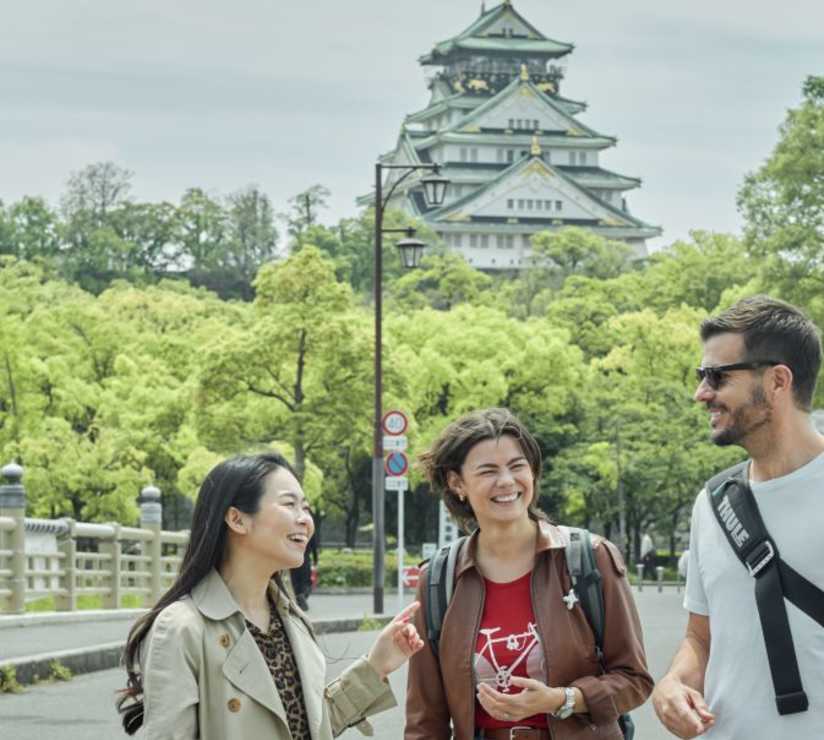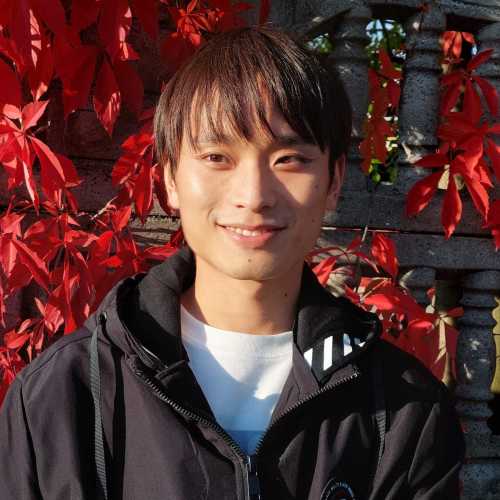Table Of Contents
- The Distance Between Two Cities
- Getting There: Trains, Time Zones, and Tensions
- First Stop: The Atomic Bomb Dome and Its Stillness
- Walking Through Peace Memorial Park
- Inside the Hiroshima Peace Memorial Museum
- Lunch Break: Hiroshima-Style Okonomiyaki
- Optional Side Trip: Miyajima Island in an Afternoon
- Final Stop: Hiroshima Castle or Orizuru Tower
- Returning to Osaka: Quiet Reflections
- Is a Day Trip to Hiroshima Worth It?
- Practical Planning: Making Your Day Trip Work
- Beyond Tourism: What This Experience Really Offers
- Food, Culture, and Small Details That Matter
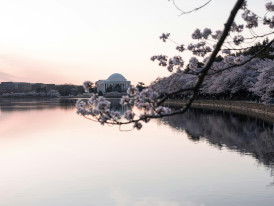
City Unscripted article image
A sunrise view of the Hiroshima Peace Memorial Park with the Atomic Bomb Dome in soft morning light. Photo by Jeffrey Clayton on Unsplash

A watch lying on a Hiroshima station bench
The Distance Between Two Cities
I usually pause when friends ask about taking an Osaka day trip to Hiroshima. Not because it's impossible; the bullet train makes it ridiculously easy, but because I'm never sure how to explain what you're really signing up for. This isn't your typical day out.
I'd been living in Osaka for three years before I finally made the trip. Part procrastination, part that peculiar resistance you develop to places everyone says you "must" visit. But when my cousin from Vancouver asked me to show her something "essentially Japanese" during her brief layover, Hiroshima felt like the only honest answer.
The plan was simple: catch the first reasonable train, spend the day absorbing what we could, return to Osaka by evening. What I didn't expect was how the day would stretch and compress time in ways that had nothing to do with train schedules.
Looking back, that day trip from Osaka to Hiroshima taught me more about Japan and about the weight of bearing witness than months of living in Kansai ever had.
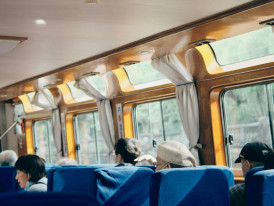
Interior of a Shinkansen train with early commuters Photo by Seele An on Unsplash
Getting There: Trains, Time Zones, and Tensions
The logistics are the easy part, which is probably why everyone focuses on them.
The bullet train from Shin Osaka Station to Hiroshima Station takes exactly one hour and eleven minutes. Trains depart roughly every fifteen minutes during peak hours, less frequently but still regularly throughout the day. If you have a Japan Rail Pass, the trip costs nothing extra. The JR Pass also covers other routes, such as the ferry to Miyajima, making it a cost-effective option for travelers visiting multiple cities. Without one, expect to pay around ¥10,000 for a non-reserved seat.
Buses are also available as an alternative for those seeking a more budget-friendly or flexible travel option. The bus from Osaka to Hiroshima typically takes about 5 to 6 hours, with departures from major bus terminals like Osaka Station and ticket purchasing available at the station or online.
I caught the 7:16 am departure, which felt civilized enough without being masochistic. The train was maybe half-full; a mix of business travelers with perfect posture and tourists clutching guidebooks like prayer books.
There's something surreal about hurtling toward Hiroshima at 300 kilometers per hour while sipping coffee from a can and watching rice fields blur past your window. The Shinkansen's famous punctuality and comfort create this bubble of normalcy around what is, fundamentally, a pilgrimage.
The countryside between Osaka and Hiroshima is unremarkably beautiful. Rolling hills, tidy farms, the occasional cluster of houses with blue tile roofs. Nothing in the landscape suggests what happened here eighty years ago, which is perhaps the point.
As we approached Hiroshima Station, I found myself checking my phone for the time more frequently than necessary. Not because I was running late, but because I was about to confront a place where time itself had been violently interrupted.
For my plan, the logistics of traveling from Osaka, taking the train or other transportation to Hiroshima, were straightforward and stress-free.
Looking for a private city experience in Osaka?
Explore the city with a local who plans a private day just for you; no groups, no scripts.
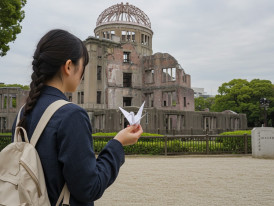
A tourist standing silently by the Atomic Bomb dome, holding a paper crane.
First Stop: The Atomic Bomb Dome and Its Stillness
The Atomic Bomb Dome sits in downtown Hiroshima like a broken tooth. It is a UNESCO World Heritage Site and a world heritage site recognized for its historical significance.
I'd seen photos, of course. But photos can't capture the strange intimacy of standing near something that survived the unsurvivable. The dome, what remains of the former Hiroshima Prefectural Industrial Promotion Hall, is smaller than you expect, more fragile-looking than the iconic images suggest.
What strikes you first isn't the obvious symbolism, but the mundane details. The way grass grows around the base. The careful maintenance of the viewing area. The fact that people still live and work in buildings nearby, going about their Tuesday morning business while tourists like me gawk at catastrophe frozen in rebar and concrete.
Hiroshima was the site of the first ever atomic bomb used in warfare, and the devastation caused by the bombing resulted in the deaths of tens of thousands of people. The attack marked the beginning of the nuclear weapons era, and the Dome stands as a reminder of the destructive power of atomic bombs.
The famous Atomic Bomb Dome draws visitors from around the world, but it resists easy consumption. You can't really photograph the feeling of standing there. You can't Instagram the weight of silence that settles over even the most chattering tour groups.
I spent maybe twenty minutes walking around the perimeter, trying to process what I was seeing. Twenty minutes feels like nothing when you're looking at the epicenter of history. It also feels like forever when that history refuses to resolve into simple lessons or clear emotions.
The dome doesn't offer comfort or closure or even clarity. It just sits there, stubborn in its brokenness, insisting you look.

Paper cranes at Children's Peace Monument Photo by Amy Kimmis on Unsplash
Walking Through Peace Memorial Park
From the Atomic Bomb Dome, I crossed the Motoyasu River into Peace Memorial Park. The transition feels intentional; from remnant of destruction to space designed for reflection.
Peace Memorial Park stretches along the river in a carefully orchestrated landscape of lawns, monuments, and pathways. It's beautiful in the way that memorial spaces are beautiful: solemn, green, designed to encourage contemplation rather than hurry.
The Children's Peace Monument draws the largest crowds, and for good reason. The monument is dedicated to Sadako Sasaki, a young girl who developed leukemia after the bombing and became a symbol of peace. Her story of folding paper cranes is rooted in a Japanese legend that promises a wish to anyone who folds a thousand cranes. She died before reaching a thousand cranes, but her classmates finished the count.
What you see at the monument are the literal millions of paper cranes sent by school children from around the world. They arrive in boxes, bundles, elaborate displays. Some are made from traditional origami paper, others from candy wrappers or notebook pages. The colors blur together into something that's simultaneously hopeful and heartbreaking. The monument and the park serve as a message to future generations about the importance of peace and the need to remember the past to prevent similar tragedies.
I watched a group of Japanese elementary students place their own contribution; a thousand cranes strung on colored thread, accompanied by a handwritten banner in English: "Never Again." Their teacher explained something to them in rapid Japanese while they bowed their heads.
The peace memorial isn't subtle. It doesn't pretend that quiet symbolism alone can contain what happened here. Instead, it accumulates meaning through repetition; thousands of visitors, millions of cranes, decades of determined remembering.
Walking through Peace Park, you become part of that accumulation whether you want to or not.
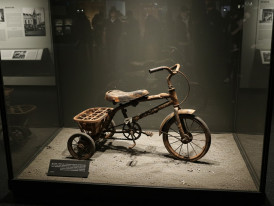
A charred tricycle on display hiroshima museum exhibit
Inside the Hiroshima Peace Memorial Museum
The Hiroshima Peace Memorial Museum requires a different kind of preparation than most museums.
Before you visit, note that the entrance fee for the Hiroshima Peace Memorial Museum is currently 200 yen for adults. Tickets can be purchased on-site or in advance.
I'm not talking about buying tickets in advance (though you should) or planning your route through the exhibits. I'm talking about the mental preparation required to spend two hours confronting humanity at its worst and most resilient.
The Peace Memorial Museum doesn't sensationalize. It doesn't need to. The exhibits are methodical, chronological, relentlessly factual. You learn about the development of the atomic bomb, the decision to drop it, the immediate aftermath, and the long-term consequences.
What stays with you aren't the statistics, though the numbers are staggering, but the personal artifacts. A child's lunch box, charred black. A watch stopped at 8:15. Clothing with shadows burned into the fabric.
The museum walks a careful line between education and exploitation. Everything is presented with dignity, context, and historical rigor. But dignity doesn't diminish impact. If anything, the restraint makes the horror more vivid.
I spent longer in the Hiroshima Peace Memorial Museum than I'd planned. Not because I was enjoying myself, "enjoy" isn't the right word for this experience, but because leaving felt like abandoning something important.
The final exhibit focuses on current peace efforts and nuclear disarmament advocacy. It's hopeful without being naive, urgent without being shrill. You leave with information about what you can do, if you're so inclined.
Whether you're so inclined might depend on how the previous two hours have affected you.
What if your day in Osaka was planned by someone who knows it — and you?
City Unscripted matches you with a local host who creates a private experience based on your interests, not a set route.

A handwritten menu from a backstreet okonomiyaki joint Photo by Zero on Unsplash
Lunch Break: Hiroshima-Style Okonomiyaki
After the museum, I needed something immediate and uncomplicated. Food, specifically the kind of food that connects you to a place through your senses rather than your emotions.
Hiroshima-style okonomiyaki provided exactly that escape.
If you know Osaka's version of okonomiyaki, ingredients mixed together into a batter, cooked as one unit, then Hiroshima's approach will surprise you. Here, the components are layered: cabbage, bean sprouts, yakisoba noodles, egg, whatever protein you've chosen, all stacked carefully and flipped as a unit. Hiroshima-style okonomiyaki typically includes yakisoba noodles layered with the other ingredients, which sets it apart from the Osaka style.
I found a counter-style place near Hiroshima Station, the kind where you watch the cook work directly in front of you. No English menu, but pointing works fine. The result was a towering stack of textures and flavors that bore only passing resemblance to Osaka's version.
The differences aren't just culinary, they're cultural. Osaka okonomiyaki gets mixed together, egalitarian and efficient. Hiroshima okonomiyaki maintains distinct layers, each ingredient contributing separately to the whole. It's a small distinction that feels meaningful after a morning of thinking about how places develop their own responses to history.
Plus, it's genuinely delicious. The noodles add substance, the layering creates interesting textural contrasts, and the sauce, subtly different from Osaka's version, ties everything together without overwhelming individual flavors.
I ate slowly, watching the cook prep orders for a steady stream of locals. The mundane pleasure of hot food and cold beer felt like exactly what I needed before diving back into the day's more demanding experiences.
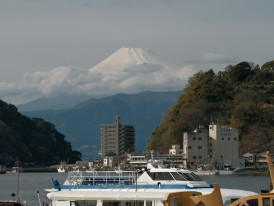
Ferry from Miyajimaguchi Photo by b_rolls on Unsplash
Optional Side Trip: Miyajima Island in an Afternoon
If you're making a day trip from Osaka to Hiroshima, consider extending it to Miyajima Island. The logistics work, barely, if you're efficient with your time and willing to accept a somewhat rushed experience.
From Hiroshima Station, take the JR Sanyo line to Miyajimaguchi station, about 25 minutes. Miyajimaguchi station is the transfer point from the JR Sanyo line to the ferry terminal. After arriving at Miyajimaguchi station, visitors walk to the nearby ferry terminal to board the ferry to Miyajima Island. From there, the JR Ferry to Miyajima Island takes another 10 minutes and is covered by the Japan Rail Pass.
Miyajima Island exists in a completely different emotional register than Hiroshima proper. Where the city confronts you with difficult history, the island offers something closer to traditional Japanese aesthetics: ancient shrines, tame deer, picture-perfect landscapes.
The famous floating torii gate of Itsukushima Shrine is undeniably stunning, especially during high tide when it appears to float on the water. But it's also undeniably crowded, especially during afternoon hours when day-trippers like me arrive. Mount Misen is another highlight, a popular hiking destination on the island offering panoramic views, accessible by ropeway or hiking trails.
I had maybe ninety minutes on the island before needing to catch the ferry back to maintain my return schedule to Osaka. Enough time to visit Miyajima Island's main attractions, take the requisite photos, and sample some of the local maple leaf-shaped sweets. Momiji-manju, a maple leaf-shaped cake filled with red bean paste, is a specialty of Miyajima and a must-try for visitors.
But not enough time to really absorb the place. Miyajima Island deserves a more leisurely approach, ideally staying overnight to experience the shrine at different tides and times of day.
If you're pressed for time, skip Miyajima and spend the extra hours in Hiroshima proper. But if you need a palate-cleanser after the intensity of the Peace Memorial Museum, the island's beauty provides exactly that relief.
The contrast isn't accidental. Traditional Japan and atomic Japan coexist here, sometimes uncomfortably, always thoughtfully.

Hiroshima Castle reflection in the moat at dusk Photo by Isaac Mitchell on Unsplash
Final Stop: Hiroshima Castle or Orizuru Tower
Before heading back to Osaka, I had time for one final stop. The choice came down to Hiroshima Castle or the Hiroshima Orizuru Tower; both are located in the city center and within walking distance of the train station, offering different perspectives on the city.
I chose the Hiroshima Orizuru tower, partly for the views and partly because the name intrigued me. "Orizuru" means paper crane, and the tower, a recent addition to Hiroshima's skyline, explicitly connects to the peace memorial themes I'd been grappling with all day.
The observation deck provides panoramic views of the city, including clear sightlines to both the Atomic Bomb Dome and Peace Memorial Park. From this height, you can see how the memorial spaces fit into the larger urban fabric, how normal life continues around sites of extraordinary significance.
The tower also includes interactive exhibits about paper crane folding and peace education. It's less intense than the museum but maintains thematic coherence with the day's experiences.
Hiroshima Castle, by contrast, is a reconstruction of the original castle destroyed in the atomic bombing. The castle grounds are open for exploration, featuring gardens, historical features, and notable trees. Within the castle grounds, you'll find the Gokoku Shrine. This important religious site was rebuilt after the bombing and plays a significant role in local festivals and New Year's celebrations. The castle itself houses a history museum focused on Hiroshima's pre-1945 past, samurai culture, feudal politics, and regional development. A different kind of remembering.
Both options have merit, but the Rizuru Towerr felt like a more appropriate conclusion to this particular day. The views provided geographic context for everything I'd seen, while the crane symbolism offered a gentle transition back toward everyday life.
Plus, the gift shop sells surprisingly tasteful origami supplies, if you're inclined toward tangible mementos.
Tip
We match you with the right host, not just any guide.Want to experience the real Osaka with someone who lives there?
A fully private experience, planned and led by a local host who tailors the day to you

A person journaling on the train back to Osaka
Returning to Osaka: Quiet Reflections
The return trip to Osaka Station felt different than the morning journey. Same train, same route, same comfortable seats and punctual service. But I was different.
I spent most of the ride staring out the window, trying to process the day. The bullet train's smooth efficiency seemed surreal after hours spent contemplating destruction and reconstruction.
Other passengers were checking phones, napping, chatting quietly. Normal activities that felt both comforting and strange after bearing witness to atomic devastation.
The answer, I realized, is that you don't transition cleanly. You carry it with you. By the time we reached Shin Osaka station, I'd decided that carrying that weight was exactly the point.
Some places resist easy consumption, and Hiroshima is one of them. The city offers itself for witness, not entertainment.

Sunset over Hiroshima Bay. photo by KimonBerlin on Creative Commons Attribution-Share Alike 2.0
Is a Day Trip to Hiroshima Worth It?
The question everyone asks is whether you can meaningfully experience Hiroshima in a single day. Many travelers look for a one-day itinerary or a Hiroshima day trip itinerary to make the most of their limited time.
The answer depends on what you mean by "meaningful."
If you're looking for comprehensive historical understanding, probably not. The stories Hiroshima tells are layered, complex, resistant to quick consumption. A one-day visit barely scratches the surface of what there is to learn and absorb.
But if you're asking whether a Hiroshima day trip can provide genuine insight, emotional impact, and lasting perspective, then yes, absolutely. For many, to visit Hiroshima, even for a day, is a meaningful experience and a recommended addition to any Japan itinerary. Sometimes brief, intense encounters with difficult subjects create more lasting impressions than extended, comfortable study. Visiting Hiroshima, even on a tight schedule, can be deeply impactful.
The Osaka day trip to Hiroshima I'd planned as a tourist obligation became something more substantial: a confrontation with history that refuses simple interpretation, a reminder that some human experiences exist beyond the reach of casual understanding.
Would I recommend it? Yes, with caveats.
Go if you're prepared to be uncomfortable. Go if you can handle having your assumptions challenged. Go if you're willing to leave with more questions than answers.
Don't go if you're looking for entertainment or easy emotional catharsis. Don't go if you need every experience to fit neatly into your existing worldview.
The bullet train makes Hiroshima accessible from Osaka in ways that would have been unimaginable in previous generations. But accessibility isn't the same as comprehensibility. Some distances can't be collapsed by technology, no matter how efficient.
Hiroshima rewards visitors who approach it with patience, humility, and genuine curiosity about difficult subjects. If that describes your travel style, then the day trips from Osaka to Hiroshima or following a Hiroshima day trip itinerary might be exactly what you need.
If not, there are plenty of other Osaka experiences that will leave you feeling more comfortable and less challenged.
The choice, like everything else about travel, depends on what you're actually looking for.
Practical Planning: Making Your Day Trip Work
Morning Departure Strategy
The first train you catch sets the tone for everything that follows. Leave Shin Osaka station no later than 8:00 am if you want adequate time for both the Peace Memorial Park and Hiroshima Peace Memorial Museum without feeling rushed.
Earlier departures, 7:00 or 7:30 am, give you flexibility for spontaneous decisions, such as adding Miyajima island to your itinerary or spending extra time in particular locations.
Book your outbound ticket the night before if you're traveling during peak seasons or holidays. The bullet train rarely sells out completely, but specific departure times can fill up.
Navigation and Logistics
Hiroshima station efficiently connects to all major attractions via streetcar, bus, or walking. The atomic bomb dome and Peace Memorial Park are about fifteen minutes on foot from the station or one stop on the streetcar.
Most international visitors find walking the most straightforward option, especially if you're only carrying a small day bag. The route takes you through downtown Hiroshima, providing context for how the memorial spaces fit into contemporary urban life.
Download offline maps before departing Osaka. Cell service is generally excellent, but having backup navigation prevents stress if you encounter technical difficulties.
Time Management Reality
Budget at least two hours for the Hiroshima Peace Memorial Museum. You can rush through in ninety minutes, but you'll miss important context and leave feeling unsatisfied.
The Atomic Bomb Dome and Peace Memorial Park require a minimum of another hour, longer if you want to read memorial inscriptions or spend time in quiet reflection.
Add Miyajima island only if you have at least four hours total in Hiroshima. The ferry connections and walking between sites consume more time than expected, especially during busy periods.
Factor in meal time. Hiroshima-style okonomiyaki deserves proper attention, not hurried consumption between major attractions.
What to Bring
Comfortable walking shoes are essential. A small notebook for thoughts and impressions. Cash for admission fees and meals. Many smaller establishments still don't accept credit cards.
Weather and Timing
Summer requires sun protection and hydration. Winter offers clearer views but shorter daylight. Spring crowds peak during cherry blossom season; gorgeous scenery, but longer lines.
Return Journey Planning
Book your return ticket before sightseeing to eliminate end-of-day decision fatigue. Allow buffer time for unexpected delays; missing your planned train isn't catastrophic, but it adds unnecessary stress.
Consider reserved seating for the return journey. After hours of walking and emotional processing, guaranteed seating provides welcome comfort.
Ready to plan your perfect day in Osaka?
Start your experienceBeyond Tourism: What This Experience Really Offers
Making It More Than Tourism
Most visitors approach Hiroshima as tourists consuming historical education. For those who prefer structured learning, joining a guided tour can provide additional context and insights, enriching your understanding of Hiroshima's history and major sites.
Try thinking of yourself as a witness instead of a consumer. The distinction affects how you engage with everything from museum exhibits to casual conversations with locals.
Long-term Impact
The most valuable aspect of this day trip from Osaka to Hiroshima might not become apparent for months or years. Keep a record of your immediate impressions; they'll reveal how your understanding evolves.
Suppose Hiroshima is part of a longer Japan itinerary. In that case, travelers often combine a visit with other destinations such as Kyoto, Osaka, or Tokyo to understand Japan's history and culture better.
Food, Culture, and Small Details That Matter
Beyond the Famous Okonomiyaki
While Hiroshima-style okonomiyaki deserves its reputation, the city offers other culinary experiences worth seeking out if time permits.
Hiroshima-style tsukemen, noodles served with concentrated broth for dipping, originated here and remain a local specialty. Local oysters, when in season, are among Japan's finest, served grilled, fried, or raw near the Peace Memorial Park.
Urban Design and Memory
The relationship between memorial spaces and contemporary urban development in Hiroshima offers lessons in how cities integrate difficult histories into ongoing daily life.
Notice how modern buildings relate to the atomic bomb dome and Peace Memorial Park. Hiroshima Castle's reconstruction illustrates different approaches to historical preservation; it was rebuilt to serve educational functions while acknowledging its destruction.
Making Return Visits
Each season offers different experiences of the same spaces. The infrastructure makes repeat visits entirely feasible as day trips from Osaka to visit Hiroshima. Some places are worth visiting once. Others, like Hiroshima, are worth visiting as often as your understanding can accommodate new layers of meaning.
The train back to Osaka station leaves when it leaves. But the questions Hiroshima raises can accompany you for much longer than a single day, if you let them.
For more unique ways to explore the Kansai region, discover other things to do in Osaka that go beyond typical tourist attractions.
What if your day in Osaka was planned by someone who knows it — and you?
City Unscripted matches you with a local host who creates a private experience based on your interests, not a set route.
Want to experience the real Osaka with someone who lives there?
A fully private experience, planned and led by a local host who tailors the day to you
